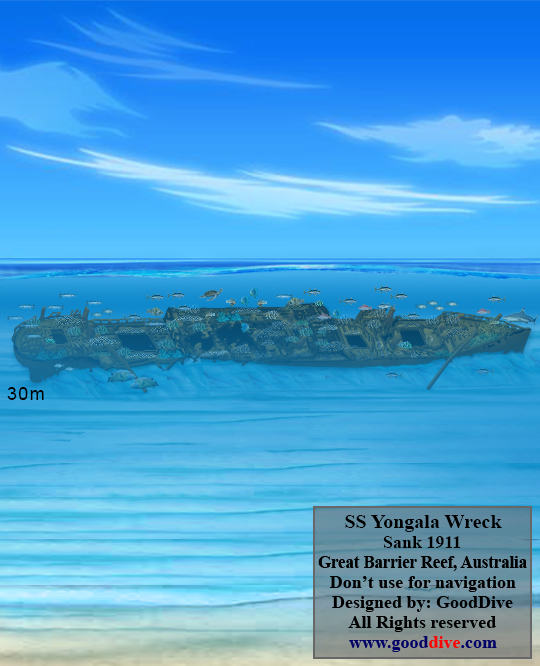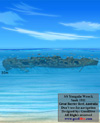Dive guide of Montego Bay
Home
SS Yongala Wreck
For exploring of wrecks make sure to have the required training level and equipment!
Check with your dive center to have all necessary information for safety!
Always dive according to that and to the current conditions! 
The SS Yongala rests on the sandy seabed, inclined to its starboard side, in 30m depth, its upper sections reach about 15m below the surface. With a length of 109 m the Yongala is the largest and most intact historical wreck of Australia.
After more than 100 years the wreck has become an artificial reef with an abundance of marine life.
And everything is big! Fascinating purple soft corals and large hard corals cover the wreck. Diving in a “fish soup” of giant groupers, huge trevallies, big marble rays, schools of barracuda, turtles and white tip reef sharks make the dive an unforgettable experience, but you can also find octopus, colorful nudibranches and sea horses.
Diving across the upper deck, you see the port hull, richly covered with soft corals and sponges. The view into the compartments and along the companionways is disturbed by schools of fish.
Under the bow there are big groups of jacks and sweetlips; moving along the sandy bottom towards the stern you can encounter huge napoleons. Each of the broken spars from the deck that are leaning on the sand is surrounded by squadrons of fish.
The stern attracts many photographers who take a shot of the rudderless rudder area.
Due to frequent strong currents at this dive site, it is only recommended for advanced divers.
Australia Wrecks
The Australian coastline is littered with innumerable wrecks partly historical, partly from the 2nd World War, as well as those from more recent times, that fell victim to reefs or heavy storms.
There are more than 8000 wrecks registered around Australia’s coast, but the list is probably not complete yet.
All shipwrecks and associated leftovers that are 75 years old or more are protected by law as historical wrecks. They are like underwater museums and therefore provide special opportunities for scientific studies. At the wrecks that have been released for recreational diving it is strictly forbidden to remove relics or to destroy any part of the vessels.
In the Northern Territory, the area around Darwin, the capital of the state, is considered to be the best for wreck diving. During a Japanese air attack in 1942 lots of ships and planes were destroyed and 32 years later a cyclone was responsible for the loss of many boats.
Queensland is famous for the amazing marine life of the Barrier Reef that attracts millions of divers, but it offers some very interesting wreck dive spots as well.
Western Australia boasts a big history concerning ship wrecks. There are some historic wrecks that sank in the 17th Century that still are perfect for diving. Famous also are some wrecks that had been sunk deliberately to form artificial reefs.
New South Wales has one of the most varied and interesting coastlines for scuba diving, from temperate water marine life in the South to tropical species in the North. Along the 1100 km coastline more than 2000 ship wrecks of all types and sizes are registered. Some of them offer great wreck dives.
Victoria is famous for its Ship’s Graveyard that covers about 20 km of the Victorian coastline between Torquay and Port Phillip Heads. During the time between 1913 and 1999 a lot of obsolete vessels have been purposely disposed there. Most of the ships are still not explored, but still there is a big choice of wreck dive sites. On top of it, the tempered water offers a rich variety of marine life.
Tasmania, the island in the very South of Australia is known for its powerful winds due to its geographical position. These winds led to the destruction of many ships. More than 1000 vessels have been wrecked in Tasmanian waters.
The tempered waters of South Australia provide a huge diversity of marine life and a lot of interesting wreck dives. Some ships were scuttled on purpose in order to create artificial reefs.
 SS Yongala Wreck
SS Yongala Wreck
The SS Yongala is one of Australia’s most popular wrecks. |











